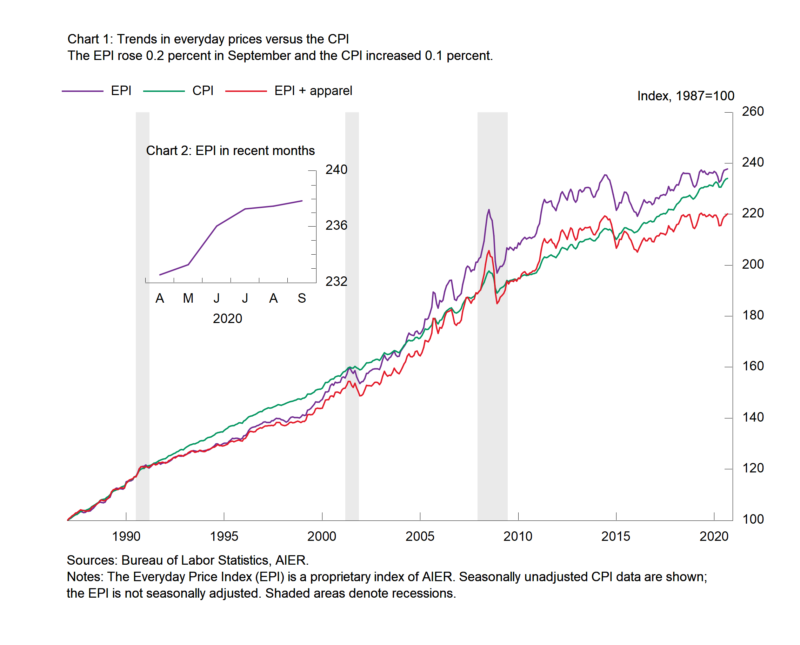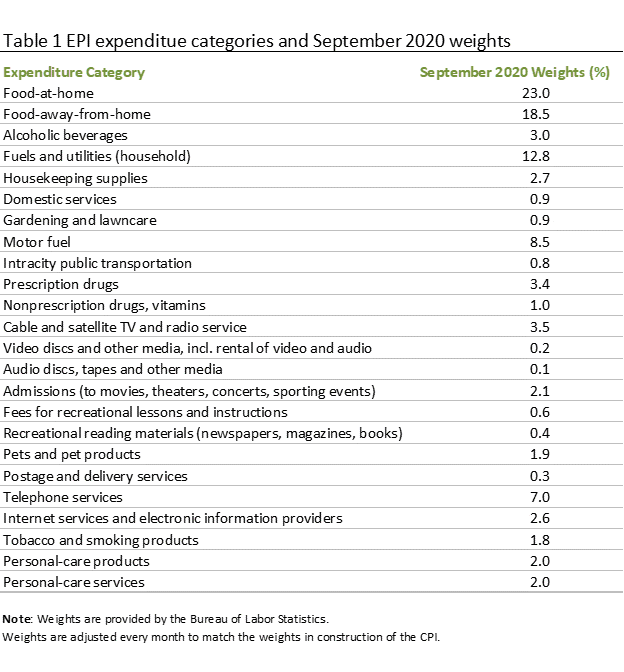Transportation Drives Prices in September
Note: The Everyday Price Index for September is based on incomplete data due to restrictions on data collection by Bureau of Labor Statistics personnel because of the Covid-19 outbreak.
The AIER Everyday Price Index rose 0.2 percent for the month of September, faster than the 0.1 percent rise in the Consumer Price Index (on a not-seasonally-adjusted basis). The Everyday Price index has risen for five consecutive months through September, pushing the twelve-month change to 1.0 percent, the fastest pace since a gain of 2.1 percent for the twelve months through February.
The Everyday Price Index including apparel, a broader measure that includes clothing and shoes, rose 0.3 percent in September after increasing 0.2 in August. The Everyday Price Index including Apparel has posted four consecutive gains from June through September 2020. Despite the gains, the index is up just 0.4 percent over the 12 months through September 2020. Apparel prices rose 2.6 percent on a not-seasonally-adjusted basis in September but are still down 6.0 percent over the past year.
The largest positive contributors to the rise in the Everyday Price index in September were intracity transportation, food away from home (primarily restaurants), and energy costs (both household energy services and motor fuel). Those gains were partially offset by declines in groceries, housekeeping supplies, and prescription drug prices.
Intracity transportation prices jumped 8.8 percent for the month on a not-seasonally-adjusted basis. That surge was a snapback following four consecutive declines including a 6.8 percent drop last month. From a year ago, intracity transportation prices are still down 0.3 percent. Prices for food away from home (restaurants) rose 0.6 percent and are 3.8 percent above September 2019. Household fuels and utilities prices gained 0.6 percent for the month and are 1.2 percent higher than a year ago while motor fuel prices rose 0.7 percent for the month but are down 15.4 percent for the year.
Partially offsetting those increases were declines of 0.4 percent in food at home (groceries), 1.2 percent for housekeeping supplies, and 0.8 percent for prescription drugs.
The Consumer Price Index, which includes everyday purchases as well as infrequently purchased, big-ticket items and contractually fixed items, rose 0.1 percent on a not-seasonally-adjusted basis in September, and 0.2 percent after seasonal adjustment. Over the past year, the Consumer Price Index is up just 1.4 percent.
For the Consumer Price Index excluding food and energy, the index rose 0.2 percent for the month after seasonal adjustment while the 12-month change came in at 1.7 percent. Within the core, core goods prices were up 0.8 percent in September and are up 1.0 percent from a year ago while core services prices were unchanged for the month and are up 1.9 percent from a year ago.
Used vehicle prices were up 2.1 percent for the month and 10.2 percent from a year ago. That gain accounts for nearly all the increase in the overall consumer price index.
Overall consumer prices are rising at a modest pace. However, they continue to be severely impacted by the shutdown of the economy. Distortions to activity and prices will continue as long as restrictions are in place.








